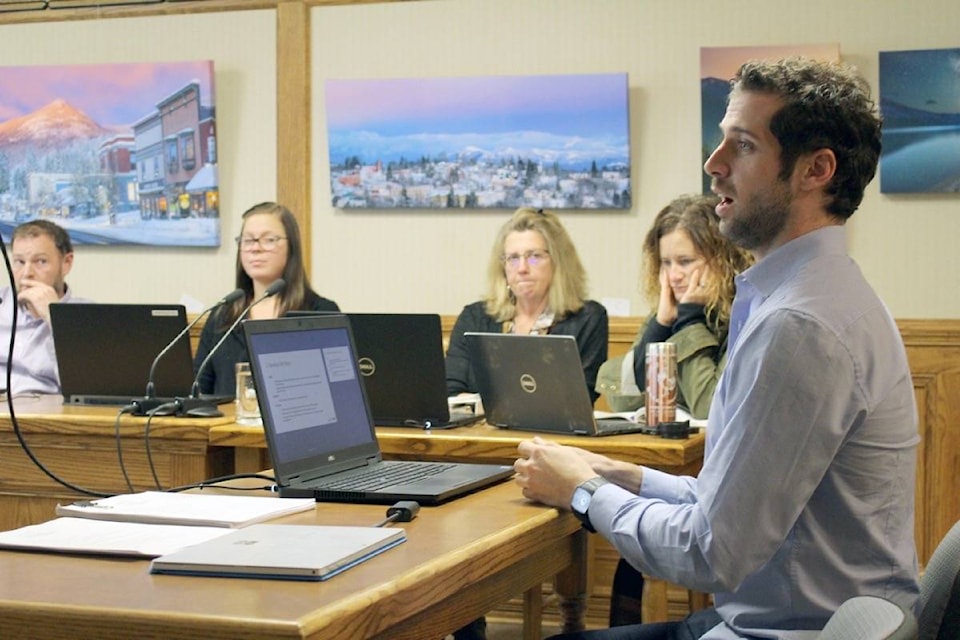The City of Rossland’s infrastructure value is $204 million, according to the city’s new asset management plan.
Cory Sivell from Urban Systems appeared before council at Monday night’s council meeting to give a presentation on the City of Rossland’s Asset Management Initiative Plan (AMIP).
His presentation included an overview of what the city has done so far: an organizational assessment, developing an asset management policy, developing a capital prioritization framework, and improving data information flow and process.
RELATED: Rossland’s asset management planning takes centre stage at BC conference
Now the city also has an AMIP, though Monday night’s meeting made it clear that asset management is an ongoing process and there is still a lot of work ahead.
Sivell explained that $204 million “would represent how much money you would need to replace all your assets in today’s dollars. That would never happen, but it’s good to know the value of your portfolio.”
Of that $204 million infrastructure value, 29 per cent is in water, 26 per cent is in roads, 19 per cent is in wastewater, 13 per cent is in buildings, 10 per cent is in storm drainage and three per cent is in fleet and equipment.
Overall, Rossland now has 47 per cent remaining life in its assets, whereas in 2011 there was 49 per cent remaining.
(Those who view Sivell’s presentation online should note that the legend to this graph is incorrect. The dark grey is 2011 and the light grey is 2017).
The biggest take away from the AMIP is the that Rossland city council now needs to decide on a strategy for how to proceed in linking its financial planning to its asset management.
Sivell presented council with a chart that combined a number of scenarios, depending on whether or not council wanted to replace an asset at the end of its standard life or increase that by 25 or 50 percent. It also included what Sivell referred to as “three investment level indicators.”
“The first one if the average annual life cycle investment [AALCI], which is a forward-looking parameter. So that says, ‘If we just built everything today, how much do we need to put away from now into the future.’ … And the next one is the 20-year annual average investment [AAI], so it says, ‘Hey, let’s just put on the blinders and let’s just focus on the next 20 years and lets get rid of our backlog and just do all the projects in that 20-year horizon,’” explained Sivell.
“And then the third one is the infrastructure deficit, which is backwards-looking and I wouldn’t focus too much on the deficit because I think there’s a lot that gets lost in translation there. I would take infrastructure deficit as a positive because it means that you are making your assets sweat and that you must be doing something right because they’re lasting past their theoretical life,” he added.
Sivell explained that it was more about deciding on the right deficit level for Rossland rather than trying to completely eliminate any deficit.
“The biggest take away from that [infrastructure deficit] is that gives you some idea of where you should invest time to do some condition inspection,” he said.
Looking at the chart provided in the AMIP, Coun. Aaron Cosbey initially leaned toward an AALCI approach, but was concerned about the cost, as even in the scenario where asset life is increased by 50 percent (the cheapest scenario using either AALCI or AAI) that approach would require a $2.6 million annual capital investment.
“What drives it for me is affordability. How much can we actually put in?” Cosbey asked.
Mayor Kathy Moore pointed out that not all of the funding for capital expenses needs to come from the tax base or user fees, and that grants will play a huge part.
“We wouldn’t be able to do a lot of these things if we didn’t have grants,” she said.
Sivell told council the decision between a long-term or short-term approach wasn’t one they would likely be able to make right away because there is a lot to be taken into account.
“I think there is a lot of consultation with the public, potentially, talking with the community members, considering risk and level of service. It’s a pretty involved thing, it’s not just a [snaps his fingers] split decision,” he said.
Toward the end of his presentation, Sivell added that a next step will be communicating with the public.
“We want to really take these messages and just educate the public on like, ‘Hey, do you know you own all this infrastructure and this is the condition.’ And we want to take a different approach and we want to do it visually, we want to do it interactive and we don’t want to sit it in a 40-page report that no one reads,” he said.
To see Sivell’s presentation, visit rossland.ca/sites/default/files/agenda_regular-meeting_november-27-_2017-11-27.pdf.
